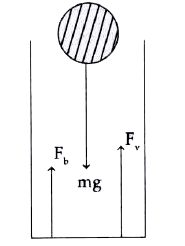Consider the motion of a small spherical steel body of mass m, falling freely through a long column of a fluid that opposes its motion with a force proportional to its speed. Initially, the body moves down fast, but after some time attains a constant velocity known as terminal velocity. If weight mg, opposing force (F,) and buoyant force (Fb) act on the body, then the correct equation relating these forces, after the terminal velocity is reached, is :
A
mg+Fv=Fb
B
mg+Fv−Fb
C
mg=Fv+Fb
D
None
Text Solution
The correct Answer is:C
Consider the situation given in the question. If we draw the free body diagram as per the given situation we will get it as follows:

Form the diagram, it can be seen that buoyancy force is net upward force where, Fv = Opposing force
Fb = Buoyancy force
Weight of ball = mg
So, mg=Fb+Fv
|
Updated on:21/07/2023
Similar Practice Problems
- Question 1 - Select One
If the force acting on a body is inversely proportional to its speed, the kinetic energy of the body is
AconstantBdirectly proportional to timeCinversely proportional to timeDdirectely proportional to square of time. - Question 1 - Select One
If the force acting on a body is inversely proportional to its speed, then its kinetic energy is
Alinearly related to timeBinversely proportional to timeCinversely proportional to the square of timeDa constant - Question 1 - Select One
If the force acting on a body is inversely proportional to its speed, then its kinetic energy is
Alinearly related to timeBinversely proportional to timeCinversely proportional to the square of timeDa constant - Question 1 - Select One
If the force acting on a body is inversely proportional to its speed, then its kinetic energy is
Alinearly related to timeBinversely proportional to timeCinversely proportional to the square of timeDa constant - Question 1 - Select One
When a spherical body falls through a viscous fluid, it experiences a viscous force, the motion of the body is
Ainitially accelerated then becomes constant.Bcontinuously accelerated.Ccontinously moving with different velocity.Dinitially constant then decreases till it becomes zero. - Question 1 - Select One
The buoyant force on a body acts in a
Avertically downward directionBvertically upward directionChorizontal directionDdirection between the horizontal and the vertical
Similar Questions
____ is a force that opposes motion.
View SolutionIf the force acting on a body is inversely proportional to its speed, the kinetic energy of the body is
View SolutionThe backward viscous force acting on a small spherical body falling through a fluid_______with the increase in velocity of the body.
View SolutionFrictional force always opposes motion of a body.
View Solution

